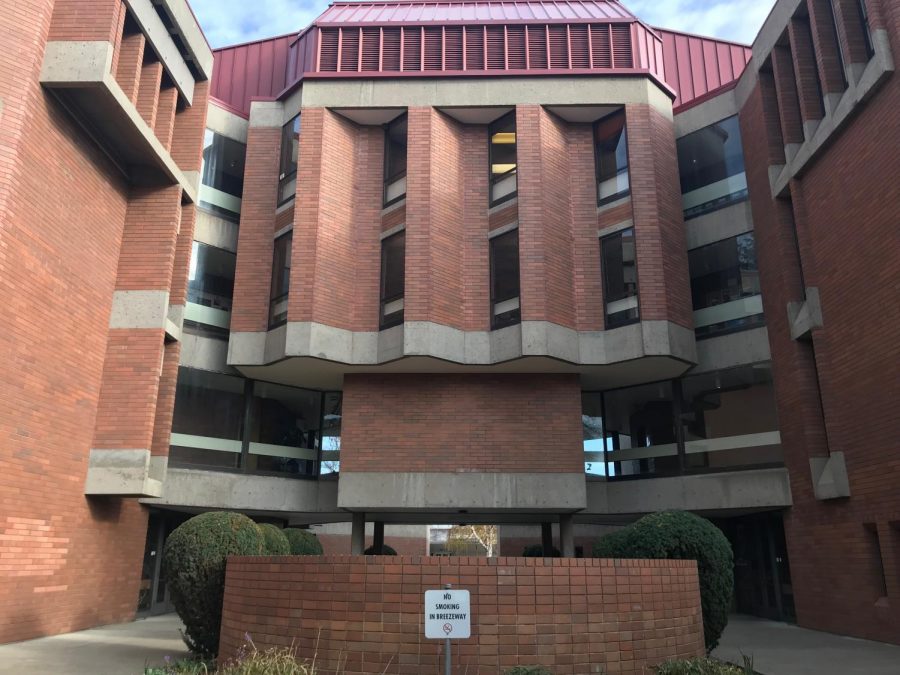L&L building showing age after nearly 50 years
Built in 1971, the Language and Literature building is showing it’s age. Some faculty have expressed concern about the building’s safety.
November 15, 2018
The Language and Literature (L&L) building has started to show signs of aging. The building was constructed in 1971 and has been eliciting a slew of complaints and concerns from some of the faculty members who work within its walls.
The problems range from uneven floors and tripping hazards to handicap accessibility issues. Some of the L&L staff feel that many of these issues pose safety concerns and may even leave CWU open to lawsuits.
On Wednesday Oct. 31, Associate Professor Jason Dormady spoke at the Faculty Senate Meeting about a problem he had noticed: the elevator is too small to fit a stretcher. If someone had a medical emergency on one of the higher floors it would present serious problems. Dormady warned that this could be a lawsuit waiting to happen.
Dormady also voiced his concerns about the level of accessibility for people with disabilities. He said that the only handicap-accessible bathroom is located in an area separated from the building which requires people to leave the building and go all the way around the backside.
He also pointed out the lack of automatic doors which can make it very difficult for some students to enter.
On Nov. 7, an office worker from the building gave a tour and pointed out a considerable number of problems they had noticed. The office worker wished to remain anonymous due to the controversial nature of the subject.
The first stop was the elevator, which had just been fixed after being out of order for a few days. According to the worker, the elevator has broken before and has gotten to the point where the worker prefers not to use it at all.
On the inside of L&L’s northern building (L&L is divided into two buildings on the first floor and joined on the second), the floor in the lobby is hazardously uneven. The concrete base beneath the carpet is broken into pieces, some of which protrude just enough that someone could catch their foot. The office worker said that they had witnessed a student trip on the floor and nearly fall head-first into the concrete stairs.
The plaza outside of the building also has problems. There are two spots where concrete has been raised over time. According to the L&L worker, staff from Facilities Management had marked these areas as tripping hazards with orange spray paint but took no further action to fix them. Since then, the spray paint has either faded away, or has been removed. There are also spots high up on the building’s exterior where pieces of concrete have broken off and fallen to ground while students were making their way to class, according to the office worker. One of these pieces was glued back into place by maintenance the next day.
Department of Philosophy and Religious Studies Senior Secretary Lynn Thompson had issues with the conditions on the third floor of L&L. She pointed out areas where rotted ceiling panels had come crashing to the ground, and said that it had taken the maintenance staff months to get around to her work orders.
Vice President of Operations Andreas Bohman said he was aware of most of the issues surrounding L&L. He explained that L&L isn’t the only building that have been experiencing issues, and that they have also been looking at Farrell Hall. CWU had planned to replace these buildings in the past, but increased student enrollment has forced the university to continue using them.
Bohman said that when it comes to issues like elevator size and lack of bathrooms, there is only so much that can be done because of the way the building was designed. He said that in the long term, CWU has plans to replace the building. As for now, his staff is doing what they can to fix these problems. Bohman said he has a team that is attempting to fix as many tripping hazards around campus as possible.
“We have to make sure our students and staff can operate in a building that’s serviceable,” Bohman said.



